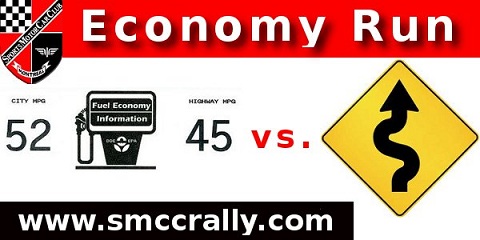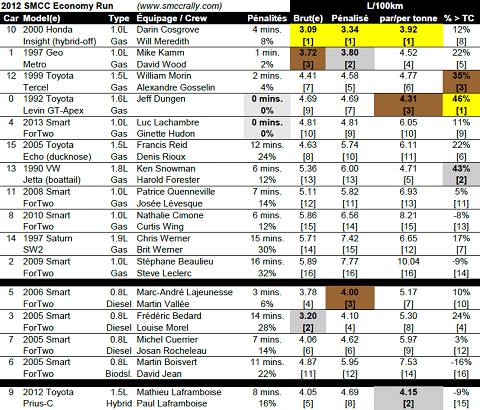The Economy Run, organized by Sports Motor Car Club Montreal, is a road rally where teams compete to achieve the lowest fuel consumption over a predetermined course. 16 cars took the start this year, up from 11 last year and 7 in 2010 when the historic event was revived. The Lanaudière region provides a scenic backdrop with an excellent variety of roads: urban, rural, highway, twisty and hilly, and straight and flat. The 198km loop means that even the most efficient teams consume more than a few litres of fuel, thereby minimizing measurement errors. As in previous years,
sunshine and moderate temperatures made for ideal conditions, especially for those running with the windows closed and the A/C off.
The Economy Run is divided into sections, each of which must be completed within a given time limit. Teams navigate the course by following simple, concise instructions and then check in at a control at the end of each section where their time is verified. A 2% fuel economy penalty is accorded for each whole minute of lateness at a checkpoint. Drivers and co-drivers are challenged to adopt a real-time strategy which maximizes their fuel economy while maintaining sufficient pace to avoid penalties.
This year, half of the field was comprised of Smarts, with half of those running on gasoline and the other half on diesel. The remainder was almost exclusively ’90s-era compacts along with two hybrids: a 2012 Prius-C and a 2000 Honda Insight, however the latter competed with its hybrid features disabled due to a damaged battery pack. Several vehicles applied home-made aerodynamic modifications including a duck nose and a truly spectacular boattail.
The route takes competitors through stop-sign infested Charlemagne and Repentigny before a 15km stretch of divided highway. From there the route quickly leaves the St-Lawrence plain for hilly, twisty sections climbing to a maximum vertical gain of nearly 400m. Maintaining momentum is a challenge, and when it is lost, competitors find themselves having to push their engines hard up hills and out of corners. However, as the route drops back down towards the plains, engine-offcoasts as long as 3km become possible for those with solid nerves. The final quarter of the rally offers plenty of flat, straight stretches perfect for hypermiling, and a chance to improve efficiency before the fill-up.
The drama of the Economy Run is in the fill-up itself. Those with economy computers have an idea of what to expect, but the pump has the final say. Competitors return to the same pump they used to fill up at the start of the rally and then apply the same fill up technique. Fuel quantities are eagerly compared between competitors, but the the final results require calculations taking into account time penalties as well as the net weight and Transport Canada economy rating of each vehicle.
Over a meal filled with plenty of discussion, the following results were calculated. For the first time, a single vehicle topped all three fuel economy metrics: raw economy, timepenalized economy and time-penalized economy per tonne. The 2000 Honda Insight driven by Darin Cosgrove and co-driven by Will Meredith achieved an incredible 3.09L/100km with four minutes of time penalties. Although technically a hybrid, the vehicle’s hybrid features were disabled for the rally, allowing it to compete in the gasoline class. Defending two-time champion Mike Kamm who held the previous record of 3.89L/100km in a 1977 Datsun B210 ceded his title, but nonetheless improved on that result in an unmodified 1997 Geo Metro to finish second in the time-penalized economy category. Moreover, the Metro was the only vehicle to score in the top five across all metrics.
Among the Smarts, the diesel variants clearly outperformed their gas siblings and took three of the top six spots in raw and time-penalized fuel economy. The 2005 Smart ForTwo of Frédéric Bedard and Louise Morel threatened the Insight with an outstanding 3.20L/100km raw economy, but required 14 minutes in time penalties to achieve this result.
The lone hybrid Prius-C finished fifth in raw fuel economy and due to its significant weight, relative to the rest of the field, achieved second place in the time-penalized L/100km/tonne category. While an excellent result, the hybrid nonetheless failed to achieve its rated Transport Canada economy.
The best improvements over Transport Canada estimates came from the older 4+ seater gasoline powered vehicles. The Toyota Levin’s top result can be attributed to event organizer Jeff Dungen’s intimate knowledge of the course. The boattailed 1990 VW Jetta, the oldest and by far most headturning entry, driven by Ken Snowman, finished a close second with a 43% improvement over TC/EPA estimates, despite some navigation errors at the start.
While the Economy Run course is not conducive to maximizing fuel economy scores, it instead provides a solid platform for comparing vehicles, modifications and driving techniques in challenging real-world conditions. Year after year, the possibility to achieve excellent fuel economy on suboptimal roads with tight time constraints has been consistently demonstrated. However, a fuel-efficient vehicle alone far from guarantees success: team strategy, an experienced, confident driver, availability of manual controls to maximize hypermiling techniques and local knowledge all combine to allow truly outstanding results. Next year, teams which balance these qualities are expected to smash the 3L/100km barrier. And we’re still waiting for an EV to complete the course and humble the field.
Final results:
For more information check out the links below:
SMCC Economy Rally
EcoModder SMCC rally forum thread
SMCC rally pictures
Popularity: unranked [?]








Comments on this entry are closed.